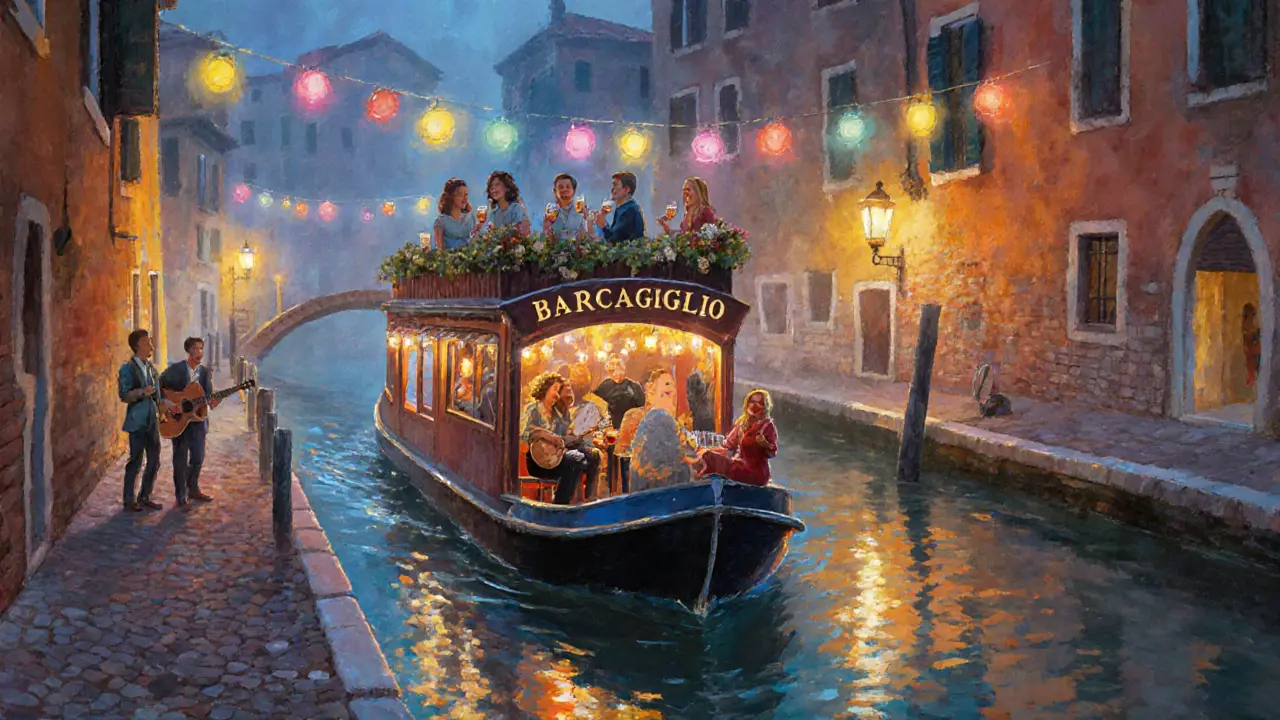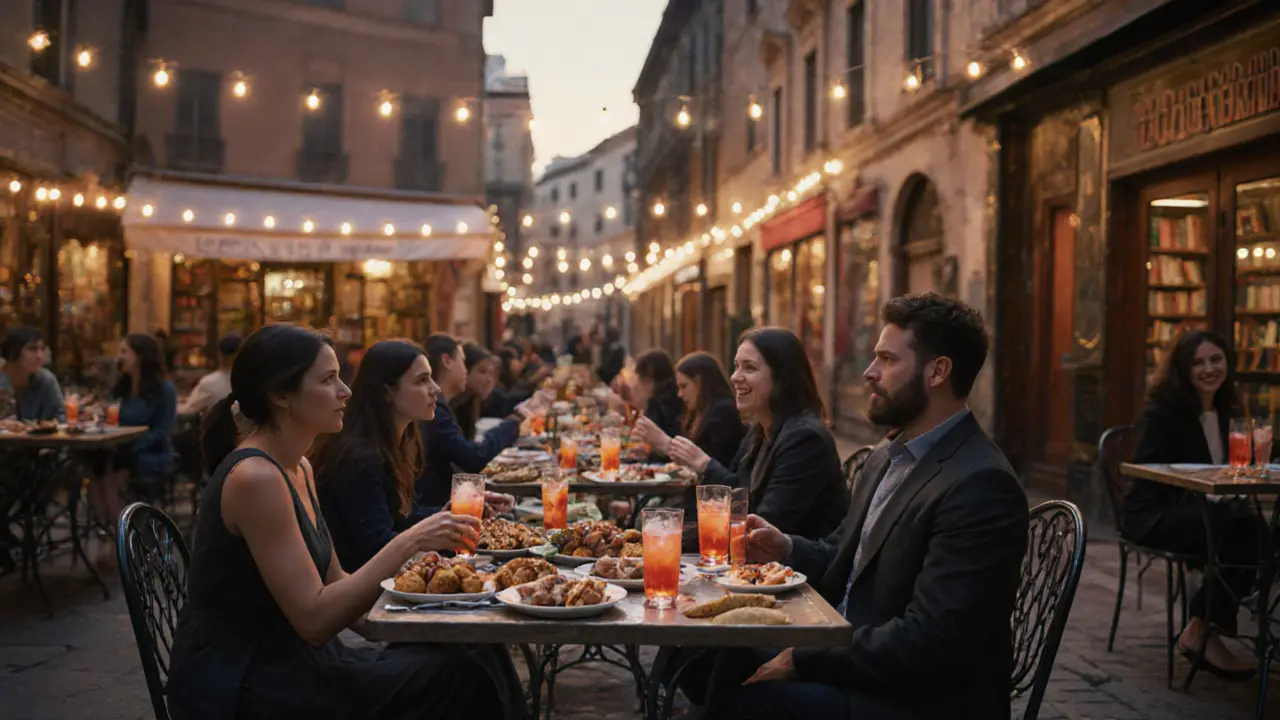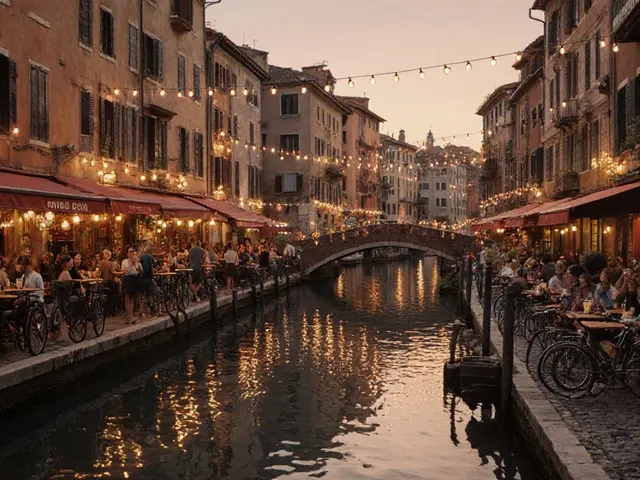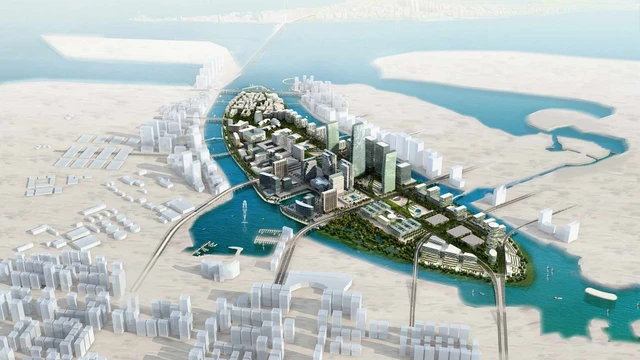Milan doesn’t sleep when the sun goes down
Most tourists leave Milan by 8 p.m., thinking the city shuts down after dinner. That’s a mistake. Milan’s nightlife isn’t just active-it’s electric, layered, and deeply Italian. You won’t find neon-lit strip malls or chain bars here. Instead, you’ll find hidden courtyards with live jazz, rooftop lounges with Aperol spritzes, and underground clubs where DJs spin vinyl until 5 a.m. This isn’t partying for the sake of it. It’s ritual. It’s culture. And it’s different every night of the week.
Start with the aperitivo-Milan’s secret weapon
If you want to understand Milanese nightlife, begin with aperitivo. It’s not a drink. It’s a whole evening. Between 6 p.m. and 9 p.m., bars across the city turn into buffet halls. For €12 to €18, you get a cocktail (usually a Negroni, Aperol Spritz, or Americano) and access to a spread of hot and cold dishes. Think arancini, truffle crostini, smoked salmon rolls, and even pasta. It’s not a snack. It’s dinner.
Some spots are legendary. Bar Basso invented the Negroni Sbagliato in 1970 and still serves it with the same precision. Terrazza Aperol on Corso Como has a view of the city lights and a line that forms before 6 p.m. La Perla in Brera is quieter, with handmade cocktails and a courtyard that feels like a secret garden. Skip the tourist traps near Duomo. The real aperitivo happens in Brera, Navigli, and Isola.
Brera: Where art meets after-hours
Brera isn’t just a neighborhood-it’s a mood. Cobblestone streets, old bookshops, and Renaissance palaces turn into intimate wine bars and speakeasies after dark. This is where Milan’s creatives unwind. You won’t find DJs here. You’ll find piano bars, jazz trios, and quiet corners where people talk for hours.
Il Gatto Nero is a classic. No sign, just a black door. Inside, it’s dim, wood-paneled, and smells like aged whiskey. The bartender knows your name by the third visit. Bar Basso is here too, but if you’ve already had your Negroni, try La Casa del Vino for natural wines from small Italian vineyards. They pour by the glass and pair them with local cheeses. If you’re looking for something different, Bar del Fico has a hidden garden and a cocktail menu that changes weekly based on seasonal herbs.
Navigli: Canals, cocktails, and street life
By day, Navigli is a postcard-canals lined with antique shops and cafés. By night, it becomes a living party. The canals glow with string lights. Boat bars drift past. People spill out onto the sidewalks with wine in plastic cups. It’s chaotic, joyful, and unmistakably Milanese.
Bar Basso has a second location here, but the real stars are the floating bars. Barcaglio is a converted barge with a rooftop terrace. Order a Bellini and watch the boats pass. La Bicicletta serves craft beer and has a tiny kitchen that makes killer fried zucchini flowers. Il Sogno is a hidden courtyard with hammocks and live acoustic sets. It’s not loud. It’s not crowded. It’s the kind of place you stumble into and never want to leave.
Weekends here turn into street festivals. Local artists set up stalls. Musicians play without amps. People dance barefoot on the cobblestones. If you want to feel like a local, skip the clubs. Come here on a Friday night with a bottle of Prosecco and just wander.

Isola: The new heartbeat of Milan nightlife
Isola used to be an industrial zone. Now it’s where young Milanese go to drink, dance, and discover new music. This is the neighborhood of choice for designers, DJs, and digital nomads. The vibe is raw, real, and unpolished. No velvet ropes. No dress codes. Just good sound and good people.
Officine Umane is the epicenter. A former factory turned cultural hub. On weekdays, it’s a co-working space. On weekends, it becomes a warehouse club. DJs play techno, house, and experimental beats. The crowd? Mixed. Young. Diverse. No one cares what you wear. Bar Luce (designed by Wes Anderson) is a retro café by day and a cocktail lounge by night. La Cucina di Isola serves pizza until 2 a.m. and has a backroom where vinyl records spin on a turntable. If you want to feel like you’re part of something new, this is where it’s happening.
Clubs: Where the real night begins
If you’re here for dancing, Milan’s clubs don’t start until midnight. And they don’t end until sunrise. The best ones aren’t in the city center. They’re tucked away in warehouses, old cinemas, and forgotten buildings.
La Scala isn’t the opera house-it’s a basement club under a 1920s cinema. It’s tiny, dark, and packed. The sound system is legendary. You’ll hear deep house and disco remixes from local DJs who’ve played in Berlin and Tokyo. Teatro degli Arcimboldi is bigger. It hosts international acts-think Charlotte de Witte, Tale Of Us. Tickets sell out fast. Capo d’Africa is a cult favorite. No website. No social media. You find it by word of mouth. It’s in a converted warehouse near Porta Genova. The music is raw. The lighting is red. The crowd is loyal. You’ll need to arrive before 1 a.m. or wait outside for an hour.
Most clubs don’t open before midnight. Don’t show up at 10 p.m. expecting to dance. That’s not how it works here. The energy builds slowly. Aperitivo. Dinner. Drinks. Then, after 1 a.m., the real night begins.
What to wear-and what not to
Milan is fashion-forward, but not in a flashy way. You won’t see neon tracksuits or baseball caps backwards. The dress code is simple: elegant casual. Think tailored jeans, a linen shirt, a leather jacket. No sneakers unless they’re minimalist white ones. Women wear dresses or high-waisted pants with heels or loafers. Men skip the hoodie. If you’re going to a club like La Scala or Teatro degli Arcimboldi, leave the flip-flops at home. Bouncers notice. They don’t always say no-but they’ll make you wait while they check everyone else.
Brera and Navigli are more relaxed. You can wear a hoodie here. But even then, people dress with intention. It’s not about being rich. It’s about being put-together. Milanese people don’t dress to impress. They dress because it’s part of how they live.

When to go-and how to avoid the crowds
Friday and Saturday nights are packed. If you want space, go on a Thursday. Or better yet, go on a Tuesday. Yes, really. Officine Umane has a weekly jazz night on Tuesdays. La Perla has live piano on Wednesdays. Bar Basso hosts guest bartenders from around the world on Mondays. These nights are quieter, but the energy is better. You’ll actually talk to people. You’ll get a seat. You’ll taste the cocktails properly.
Also, avoid the area around Piazza Duomo after 10 p.m. It’s full of tourists, overpriced cocktails, and fake Italian clubs. The real scene is 15 minutes away by metro or a 20-minute walk.
How to get around safely
Milan’s metro runs until 1:30 a.m. on weekdays and 2:30 a.m. on weekends. After that, you’ll need a taxi or ride-share. Uber isn’t widely available. Use Free Now or Beat. Both are reliable and cheaper than taxis. Walking is safe in well-lit areas like Brera, Navigli, and Isola-but avoid the outskirts near Lambrate or Porta Venezia after dark unless you know the area.
Final tip: Don’t rush it
Milan’s nightlife isn’t about checking off clubs. It’s about lingering. About sipping your aperitivo slowly. About listening to a jazz trio play a song you’ve never heard. About laughing with strangers who become friends by 2 a.m. The best nights here don’t happen in the most famous spots. They happen in the quiet corners, the hidden courtyards, the places without signs.
Ask a local where they go after work. Follow them. You’ll find something better than any guidebook.
What time do bars open in Milan for aperitivo?
Most bars start aperitivo at 6 p.m. and run until 9 p.m. Some, like Bar Basso and Terrazza Aperol, begin as early as 5:30 p.m. on weekends. Don’t show up after 9:30 p.m.-the food spread is usually gone, and the crowd has moved on.
Is Milan nightlife expensive?
Aperitivo costs €12-€18 and includes food, so it’s a good value. Cocktails at bars range from €10 to €16. Club entry is usually free before midnight, then €10-€20 after. Drinks inside clubs are €12-€18. Compared to London or Paris, Milan is reasonably priced for the quality.
Do I need to book tables or tickets?
For aperitivo at popular spots like Terrazza Aperol or La Perla, arrive before 7 p.m. to get a good seat. For clubs like Teatro degli Arcimboldi or La Scala, you don’t need to book-but arrive early. For special events or international DJs, check the venue’s Instagram. Tickets often sell out days in advance.
Are there English-speaking bartenders?
Yes, especially in Brera, Isola, and Navigli. Most bartenders speak at least basic English. But learning a few Italian phrases-like "Un Aperol Spritz, per favore"-goes a long way. They’ll appreciate it, and you’ll get better service.
What’s the best night to experience Milan nightlife?
Friday and Saturday are the busiest, but Thursday nights are ideal. Clubs are less crowded, the music is often better curated, and you’ll have more space to enjoy the atmosphere. Tuesday nights at Officine Umane or jazz nights in Brera offer the most authentic local experience.









Write a comment